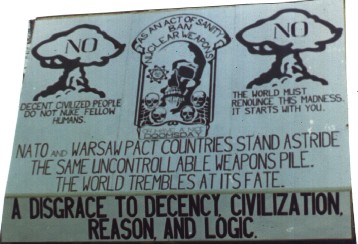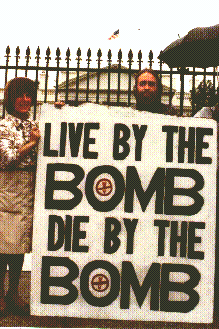Lafayette Park: Not Just Another Pretty Postcard
THE NEW YORK TIMES
FRIDAY, SEPTEMBER 7, 1984
By IRVIN MOLOTSKY
Special to The New York Times

WASHINGTON, Sept. 6 - It used to be that one could stand in the middle of Lafayette Park, look across Pennsylvania Avenue and recognize the grand view of the White House that appears on so many travel brochures. No more.
Today, between the visitor and the mansion, there are dozens of protest signs calling for an end to the arms race,eradication of the narcotics trade, elimination of the national debt and a return to a belief in God.
 Live by the Bomb/Die by the Bomb," one sign warns. "God Is the Absolute," says another, painted on a wooden billboard as big as the side of a van. Still another cries out: "Arrest Me, I Question the Validity of the Public Debt. Repeal Section 4, Fourteenth Amendment to the U.S. Constitution."Between the statues of Andrew Jackson and the Comte de Rochambeau are nine empty tents erected in a crescent shaped "Reaganville" to protest what activists contend is the lack of proper concern for the homeless on the part of the President.On the other side of Andrew Jackson, a voice rising from two loud speakers attached to a wooden platform 10 feet high ridicules people who accept the theory of evolution because, it is argued, that would require a belief that people have descended from maggots.
Live by the Bomb/Die by the Bomb," one sign warns. "God Is the Absolute," says another, painted on a wooden billboard as big as the side of a van. Still another cries out: "Arrest Me, I Question the Validity of the Public Debt. Repeal Section 4, Fourteenth Amendment to the U.S. Constitution."Between the statues of Andrew Jackson and the Comte de Rochambeau are nine empty tents erected in a crescent shaped "Reaganville" to protest what activists contend is the lack of proper concern for the homeless on the part of the President.On the other side of Andrew Jackson, a voice rising from two loud speakers attached to a wooden platform 10 feet high ridicules people who accept the theory of evolution because, it is argued, that would require a belief that people have descended from maggots.
A Look of PermanenceThe symbols of protest have a look of permanence about them. But that has not been achieved without a few court fights, here and elsewhere, between the government and the demonstrators over how to draw the line between the constitutional right to protest and the right to be left alone and enjoy a park."The problem, if that's what you want to call it, is that 10 years of court decisions have held that structures must be allowed at demonstrations, said Patricia Bangert, a lawyer with the National Park Service. Other court decisions, she added, have ordered the Government to permit demonstrations on a 24-hour basis and to allow amplified sound.Just about the only victory the government has enjoyed in this area was the Supreme Court decision June 29 upholding a ban on overnight sleeping in the National Parks near the White House. It is because of that ban that the nine tents of "Reaganville" stand empty in Lafayette Park.
'An Eyesore in Some Ways'What do tourists think of the scene?Bruce Lilley, on a visit from the Baltimore area, where he is a graduate student in biology at the University of Maryland, took no offense at the protest signs as he looked at victims of the atomic bombing of Hiroshima depicted in photographs that had been tacked to a board. "The pictures are pretty impressive," he said. "You can't get an idea of what radiation does to you until you've seen the pictures."Mr. Lilley said he saw some good in the protester's efforts. "There's Ronald Reagan over there in the White House and he looks out at this," he said. "It shows how strong the First Amendment is. It might be an eyesore in some ways, but it's better to make a mistake in favor of freedom and not to shut it down."The tents are a tempting setup for tourist photographs because a corner of the White House can be seen in the background, behind the trees in full leaf. Sharron Uhler, an archivist from the University of Missouri at Kansas City, could not resist the temptation to snap two colleagues from Topeka as they stood next to a sign that said, "Welcome to Reaganville 1984 Where Sleep is Considered a Crime.""I think it's just kind of interesting," said Miss Uhler, who was in Washington for the archivists' convention. "It's good that we can have a mini tent city in front of the White House."The tents are about 8 by 10 feet and have rust-colored sides and cream tops. They were put up by the Community for Creative Nonviolence, which is trying to find shelter for the city's homeless.The tents are empty, just like the President's promises," said Mitch Snyder, a leader of the group, which lost the case in June in the Supreme Court. The broken promises, Mr. Snyder added, included a failure by the administration to refurbish an old building that his group had used to house 700 people a night last winter.Mr. Snyder says most people, including Government officials, do not begrudge his organization the opportunity to express opposition to President Reagan by erecting empty tents in the middle of the park. But some, he said, "would trade esthetics values for the First Amendment." He said the collection of tents was not an eyesore but instead "enhances the view of the White House, especially in this Administration."
Nuclear Arms and Fast FoodMany of the protest signs concern nuclear disarmament. One, a wooden version, is about 10 feet wide and 15 feet high and says that the end of the threat of nuclear war is "The Absolute Responsibility of every rational being on this planet.""People give me money, but I use it mostly for printing," said Concepcion Picciotto, pointing to a pile of handbills and petitions behind one of her posters. She and William Thomas erected many of the signs on nuclear arms, according to their handouts.Miss Picciotto added that she had been living off discarded food from nearby fast-food shops. "But now they are under orders to lock the dumpsters, so it will feed the rats instead of people," she said.As Miss Picciotto spoke, a group of perhaps 20 Japanese tourists walked up Pennsylvania Avenue. When they got to the front of the park, half of them turned to take pictures of the White House and the other half photographed Miss Picciotto's and Mr. Thomas's signs, among them some showing bodies burned in the 1945 United States atomic bombing of Hiroshima and Nagasaki.
Concepcion Information List | Conchita Personal Story
Photographs | The President's Neighbor
 WASHINGTON, Sept. 6 - It used to be that one could stand in the middle of Lafayette Park, look across Pennsylvania Avenue and recognize the grand view of the White House that appears on so many travel brochures. No more.
WASHINGTON, Sept. 6 - It used to be that one could stand in the middle of Lafayette Park, look across Pennsylvania Avenue and recognize the grand view of the White House that appears on so many travel brochures. No more.